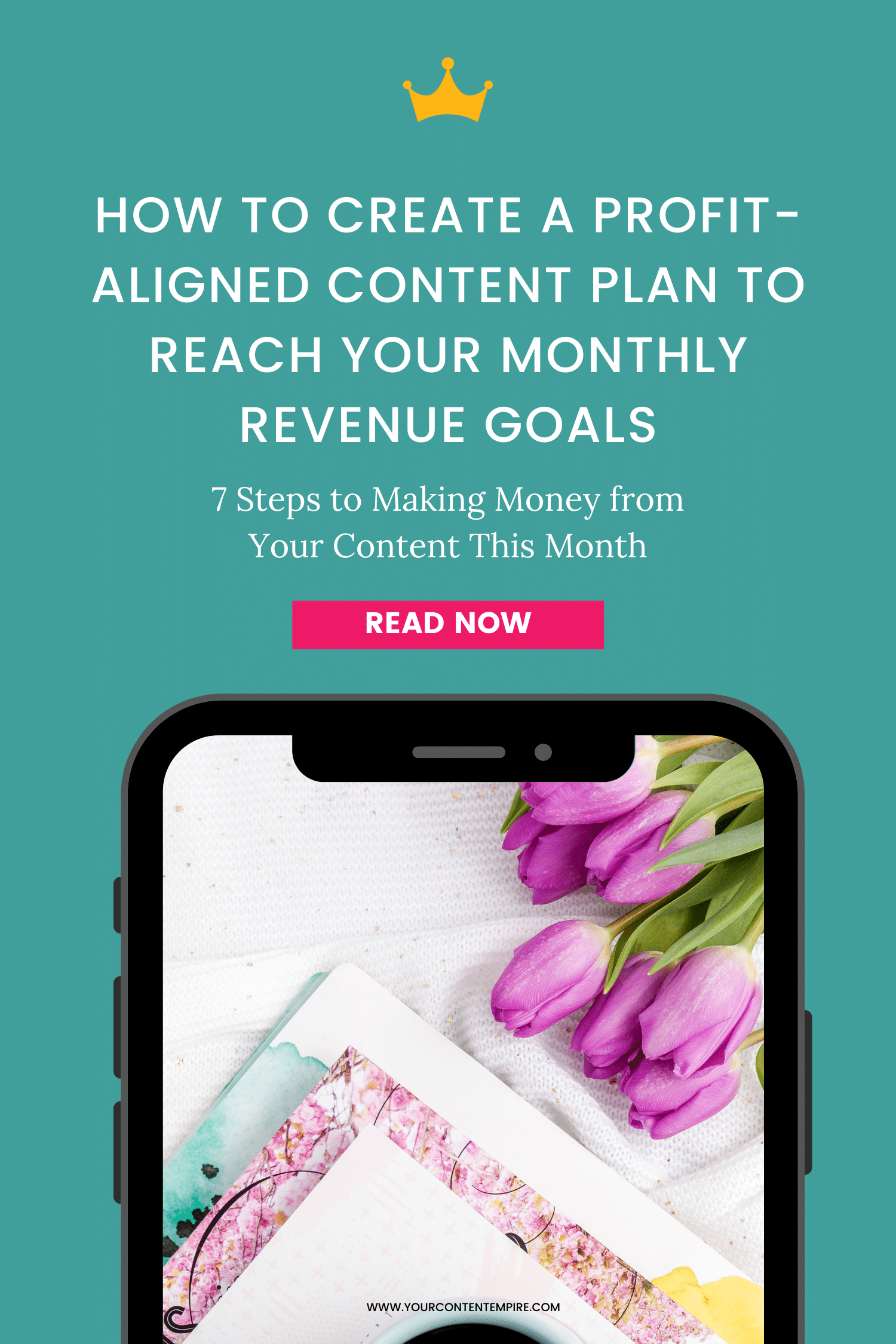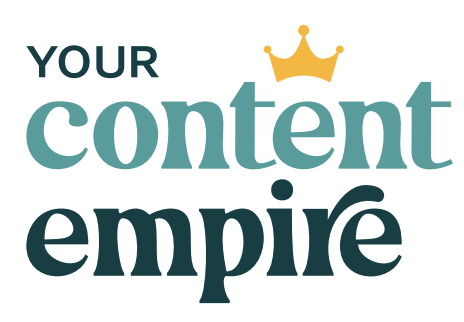Want more sales? Get them using this profit-aligned content plan. Do you ever feel stuck in a pattern of publishing your weekly blog post just because you have to? Or stuck in the create-publish-create-publish grind because it feels like something you should be doing?
There’s a big difference between content quo (a streamlined system of strategic content marketing that consistently gets you results and builds momentum towards your goals) and the “because-I-have-to” grind.
Content is the most powerful tool entrepreneurs have to grow an engaged audience and invite that audience to their paid offers. But unless it’s done as part of a profit-aligned strategy, hitting your return-on-investment for your time spent creating content will be more of a matter of luck than certainty.
That’s why I’m sharing my process for creating a profit-content plan for the month that supercharges the content you create and turns it into revenue consistently and reliably.
Ready to change the way you plan your content?
Here are the 7 steps to reaching your revenue goals using content. To put this into context, I’ll be working through a recent example from my own business to show you this process in practice.
Prefer to watch this blog post instead? Click on the video below!
Step 1 – Focus on a Specific Product or Service and Create a Goal
The first part of creating your profit-aligned content plan is to get clear on:
- The revenue goal you’d like to achieve
- The product or service that you’d like to focus on promoting for the month.
There are a couple of ways to decide on your revenue goal.
Option 1 – You can look at your revenue in previous months and increase it a little to start. Consider stretching that goal and growing it gradually over time.
Option 2 – You can base it around your expenses. What do you need to cover your business expenses? What do you want to pay yourself? And is there anything you’d like to invest in for the coming month?
Choosing a product or service to focus on promoting and selling for the month:
Are you someone who resists choosing ONE product or service to promote? It’s possible that you are unintentionally sabotaging your own marketing efforts.
A lot of my clients feel like they should focus on selling all their things, all the time. This results in confusing messages and a sort of spread-too-thin marketing that hinders their ability to sell anything at all.
A simple practice is to choose one product or service to sell for the month (or quarter). If you have multiple offers, you can cycle through them. Or if you want to run a particular promotion, you can focus on that solely for the month.
Process in Practice: The Secret Sale Case Study: Last month, I wanted to earn an extra $3K in addition to the regular recurring income that pays me and my business expenses. I was preparing for a new campaign of Facebook ads and instead of paying for it out of pocket, I wanted to “fundraise” for it instead.
The special promotion that I focused on was my secret sale. This is when I give my email list a huge discount on digital products as a way of thanking them for being in my community. I don’t promote it anywhere else except with them.
Pause before Proceeding: Do you have these in place?
- Your revenue goal for the coming month
- Your special offer or product/service focus for the coming month
Step 2 – Reverse Engineer Your Revenue Goal
The next step is to design the path to reaching your revenue goal by working backwards.
A few questions you can ask yourself to help with this are:
- What will you sell?
- At what price?
- In what quantity?
I have a tool that you can use to create your revenue plan. It works for any timeframe you need, from one month to twelve months. Click here to read the blog post and get the tool.
How it works:
- Download the spreadsheet
- Enter your revenue goal
- Enter your products and their corresponding prices
- Then play around with the quantities until you are at 100% of your goal
Process in Practice: The Secret Sale Case Study: My goal was $3K. I was selling the DIY Content Empire Kit, the Profitable Sales Funnel Generator, Your Content Rebellion and the Profitable Launch Plan Generator each for $49 (savings between $50 to $250). In order to reach my goal, I needed to sell 60 units.
Pause before Proceeding: Do you have this in place?
- Have you created your revenue plan to reach your monthly revenue goal?
Step 3 – Brainstorm How You’ll Reach that Goal

Now that you know your goal, the offer you’ll focus on, and you have a revenue plan in place, we have to brainstorm how you’ll reach that revenue goal. This is the part where you decide how you’ll sell your offer.
Take some time to brainstorm different ideas, but make sure that you’ve covered the following:
- Who you’re going to make the offer to (your audience)
- How you’re going to pique their interest (your content)
- What your messages are going to be (your messaging)
- How you’re going to get your content in front them (your channels)
- How you’re going to take an interested audience and convert them to your offer (your sales process)
Process in Practice: The Secret Sale Case Study: I run my secret sale every summer, so for me, this part was already established.
- Audience = email list
- Pique interest = 3 email series
- Messages = gratitude, special offer, 72 hours only
- Channels = email
- Sales Process = 2 emails and then last chance email for anyone who’s opened one of previous two emails
Pause before Proceeding: Do you have this in place?
- Have you brainstormed how you’ll sell your offer?
Step 4 – What content is needed?
Now it’s time to list the content needed to support your revenue plan.
- What blog posts?
- What emails?
- What social media posts?
- What PDFs?
- What pitches or interviews?
- What live videos?
- What advertisements?
Process in Practice: The Secret Sale Case Study: For my own campaign, this included 3 emails. These were emails that I updated from the previous years and simply added my new product (Profitable Launch Plan Generator).
Pause before Proceeding: Do you have this in place?
- Have you listed out all of the content needed for this month?
Step 5 – Create your monthly calendar
The next step is to build your content calendar for the coming month by placing the publish dates and offer milestones in place.
This will allow you to prioritize what content you need to create first. You can use the Content Empire Planner to do this too!
Process in Practice: The Secret Sale Case Study: In my monthly calendar, I blocked off the 72 hour period of sale and marked down the dates/times that the 3 emails would be sent out.
Pause before Proceeding: Do you have this in place?
- Have you created your content calendar?
Step 6 – Execute your profit-aligned content plan
The time has come to start creating the content you need for your promotion.
You should have a calendar and from that a list of what content you need. I like to go in order of the publish date (create the first to publish first). Create a menu for each week of content being published and content being prepped.
Process in Practice: The Secret Sale Case Study: I was lucky in that I’ve run this promotion for the past few years, so I was able to use last year’s emails and update them slightly.
Pause before Proceeding: Do you have this in place?
- Have you created the content needed for the month? Or created your weekly content creation/publishing action plan?
Step 7 – Review results
Once you’ve completed the month take a beat to measure your results against your goals. Reflect on any lessons learned and package up the content (promo messages, emails) so that you can use it when this offer is your focus again.
Questions to answer:
- What were my total sales? What was the revenue?
- How did these numbers compare to my goal?
- If I met or exceeded my goal – what can I do to push things next time?
- If I didn’t meet my goal – was it a traffic issue (not enough traffic to the salespage) or a conversion issue (not enough people clicking through the emails)? Do you think your message wasn’t resonating?
- What was the unique traffic to my: salespage, blog posts?
- What was the source of traffic: emails, social media, paid ads?
Process in Practice: The Secret Sale Case Study: I ended up with 79 total sales – or $3950. I packaged up everything I used for the sale next year and made some notes on tweaks to test for improvements next time around. Fundraising for my upcoming Facebook ad campaign – ✓ complete. I’m excited to see what this reinvestment into my business will turn into in the coming months.
Pause before Proceeding: Do you have this in place?
- Have you measured your content and promotion for the month?
- Have you packaged up any promo materials (social media messages and emails) for next time you promote this offer?
What is your focus for your next (or first) profit-aligned content plan?
Add this profit-aligned practice to your monthly content planning and you’ll notice that hitting your revenue goals (or special project fundraising goals) becomes a regular thing instead of a cross-your-fingers-and-wish kinda thing.
And if you want to get content consistent each and every month, learn the EASE content strategy here













